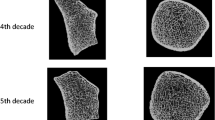Abstract
The purpose of this study was to establish reference data, in relation to age and body height, for tibial trabecular and cortical volumetric bone mineral density, bone mineral content, and cross-sectional bone geometry in healthy children and adolescents using peripheral quantitative computed tomography (pQCT). Over a 2-year period, 432 (207 male and 225 female) healthy children, with an age range of 5 to 19 years, from 6 different geographic areas in Belgium were recruited. Multislice pQCT scanning (XCT2000®, Stratec Medizintechnik, Pforzheim, Germany) was performed at the distal metaphysis (at the 4 % site) and the distal diaphysis (14 and 38 % sites) of the tibia of the dominant leg. Gender-specific centile curves in relation to age and body height were generated with the LMS method for total and trabecular volumetric bone mineral density (at 4 % site), bone mineral content, total bone cross-sectional area, periosteal circumference (all at 4, 14, and 38 % site), cortical volumetric bone mineral density, endosteal circumference, and cortical thickness (at the 14 and the 38 % site). These centile curves can be used for the interpretation of pQCT results at the 4, 14, and 38 % site of the tibia in European children and adolescents, at least when a similar methodology is used.

Similar content being viewed by others
References
Rauch F, Schönau E (2005) Peripheral quantitative computed tomography of the distal radius in young subjects—new reference data and interpretation of results. J Musculoskelet Neuronal Interact 5:119–126
Moyer-Mileur LJ, Quick JL, Murray MA (2008) Peripheral quantitative computed tomography of the tibia: pediatric reference values. J Clin Densitom. 11:283–294
Binkley TL, Specker BL, Wittig TA (2002) Centile curves for bone densitometry measurements in healthy males and females ages 5–22 year. J Clin Densitom. 5:343–353
Michels N, Vanaelst B, Vyncke K et al (2012) Children’s Body composition and stress—the ChiBS study: aims, design, methods, population and participation characteristics. Arch Public Health. 70:17
Roelants M, Hauspie R, Hoppenbrouwers K (2009) References for growth and pubertal development from birth to 21 years in Flanders, Belgium. Ann Hum Biol. 36:680–694
Cole T (1990) The LMS method for constructing normalized growth standards. Eur J Clin Nutr 44:45–60
Cole T, Green P (1992) Smoothing reference centile curves: the LMS method and penalized likelihood. Stat Med 11:1305–1319
Leonard MB, Elmi A, Mostoufi-Moab S, Shults J, Burnham JM, Thayu M, Kibe L, Wetsteon RJ, Zemel BS (2010) Effects of sex, race and puberty on cortical bone and the functional muscle bone unit in children, adolescents and young adults. J Clin Endocrinol Metab 95:1681–1689
Rüth EM, Weber LT, Schönau E, Wunsch R, Seibel MJ, Feneberg R, Mehls O, Tönshoff B (2004) Analysis of the functional muscle-bone unit of the forearm in pediatric renal transplant recipients. Kidney Int 66:1694–1706
Vandewalle S, Taes Y, Van Helvoirt M, Debode P, Herregods N, Ernst C, Roef G, Van Caenegem E, Roggen I, Verhelle F, Kaufman JM, De Schepper J (2013) Bone size and bone strength are increased in obese male adolescents. J Clin Endocrinol Metab 98:3019–3028
Binkley T, Specker B (2000) pQCT measurement of bone parameters in young children: validation of technique. J Clin Densitom. 3:9–14
Hangartner T, Gilsanz V (1996) Evaluation of cortical bone by computed tomography. J Bone Miner Res 11:1518–1524
Sievänen H, Koskue V, Rauhio A, Kannus P, Heinonen A, Vuori I (1998) Peripheral quantitative computed tomography in human long bones: evaluation of in vitro and in vivo precision. J Bone Miner Res 13:871–882
Takada M, Engelke K, Hagiwara S, Grampp S, Genant H (1996) Accuracy and precision study in vitro for peripheral quantitative computed tomography. Osteoporos Int 6:207–212
Rittweger J, Michaelis I, Giehl M, Wüsecke P, Felsenberg D (2004) Adjusting for the partial volume effect in cortical bone analyses of pQCT images. J Musculoskel Neuron Interact. 4:436–441
Acknowledgments
Inge Roggen received a grant from the Belgian Study Group for Pediatric Endocrinology. Isabelle Sioen and Sara Vandewalle are financially supported by the Research Foundation—Flanders. The study part in Aalter was co-funded by the research council of Ghent University (Bijzonder Onderzoeksfonds). The authors wish to thank the children, their parents, and the schools for their voluntary participation.
Conflict of interest
Inge Roggen, Mathieu Roelants, Isabelle Sioen, Sara Vandewalle, Stefaan De Henauw, Stefan Goemaere, Jean-Marc Kaufman, and Jean De Schepper declare that they have no conflict of interest.
Human and Animal Rights and Informed Consent
The study was conducted according to the Declaration of Helsinki guidelines and was approved by the local ethical committee of the Ghent University Hospital, and written informed consent was obtained from all the participants and their parents.
Author information
Authors and Affiliations
Corresponding author
Electronic supplementary material
Reference ranges for bone parameters: Sex-specific reference ranges for bone cross-sectional area, periosteal circumference, endosteal circumference, cortical thickness, trabecular volumetric bone mineral density, and cortical volumetric bone mineral density, according to both age and height.
Rights and permissions
About this article
Cite this article
Roggen, I., Roelants, M., Sioen, I. et al. Pediatric Reference Values for Tibial Trabecular Bone Mineral Density and Bone Geometry Parameters Using Peripheral Quantitative Computed Tomography. Calcif Tissue Int 96, 527–533 (2015). https://doi.org/10.1007/s00223-015-9988-2
Received:
Accepted:
Published:
Issue Date:
DOI: https://doi.org/10.1007/s00223-015-9988-2




